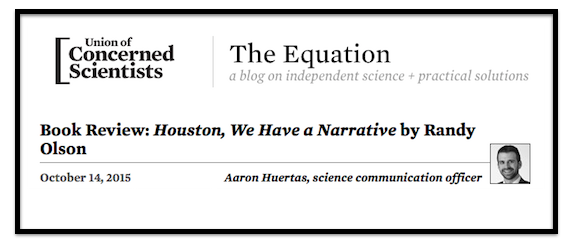Aaron Huertas of Union of Concerned Scientists has written an accurate/spot-on/pretty much perfect review of “Houston, We Have A Narrative.” UCS was the first NGO to “get it” for my first book. I can now say the same thing for this book, which is why I’ve been a fan and running workshops with them for six years now. Thank you, Aaron, for listening well.
BOOK REVIEW. It’s so nice to feel like someone has heard what you were saying. That’s called “communication.”
SOME SCIENCE ORGANIZATIONS DO LISTEN REALLY WELL
When my first book, “Don’t Be Such A Scientist,” came out in 2009 the very first major organization to contact me and ask me to come speak with them was the Union of Concerned Scientists. It’s six years later and they’ve pretty much done it again with the review of my new book by Aaron Huertas, one of their long time science communication folks (who has just left to work in the private sector — he will be sorely missed).
It takes a lot of time and effort to write and publish a book. It can be really frustrating when it finally comes out and you hear some people completely misread and misinterpret the contents. It happened occasionally for my first book — one major review accused me of advocating “bending the science to tell better stories,” a group of scientists at a major research institution tried to have me un-invited because they thought it was an anti-science book (helps if you actually open the book). And without saying who, there has already been one blog review for the new book by someone who also seems to have done little more than flip through a few pages and get offended at my critical comments about the humanities.
But Aaron Huertas has written a review that shows not only that he read and absorbed the message of the book, he also adds heft and validity to his review by applying part of the contents to the issue of vaccination.
TAKES ONE TO KNOW ONE
I guess there’s an element of “takes one to know one” — meaning that Aaron understands the book so well because he’s dealt with the same challenges I address. He hits on so many of the most important points of the book — like “Working the storytelling muscle.” Thank you for highlighting this point.
It’s one of the biggest frustrations I contend with right now — people saying, “right, got it, ABT, three words, I’m all set.” We got this with our Story Circles prototypes last spring — one participant asked why there needed to be ten meetings — basically saying, “I got the ABT on the first day and was done.” What can you do.
That’s like lifting a barbell twice at the gym and saying, “right, got it, barbells, you lift them up, I’m all set,” then going home and never returning, yet thinking you’re buff.
VISITING THE NARRATIVE GYM
It’s about “narrative fitness training” — that’s what Story Circles is about. I had one scientist at a major institution tell me this summer, “our comms people have done a great job running us through their one day storytelling workshop over the past couple years — we’ve got it down.”
No, you don’t. Sorry. It doesn’t happen in one day. It doesn’t happen in three years of film school. It doesn’t even happen in an entire lifetime, even if you win an Oscar. Last spring I asked Eric Roth, author of the screenplays for “Forrest Gump” “Munich” and countless other heavy weight movies, if at age 70 he feels like he’s “got it” on the storytelling thing — he chuckled and said, “are you kidding?”
I’m still figuring this stuff out and I’ve now written three books about it. Please don’t tell me you’ve learned all there is to know about narrative. If you have, you ought to be making millions of dollars in Hollywood. Let me know when that happens.
(FINAL NOTE: be sure to read Aaron’s account of the ABT Paul Offit tells about his wife administering a vaccination — it’s a powerful demonstration of the faulty thinking of anti-vaccinationists)

